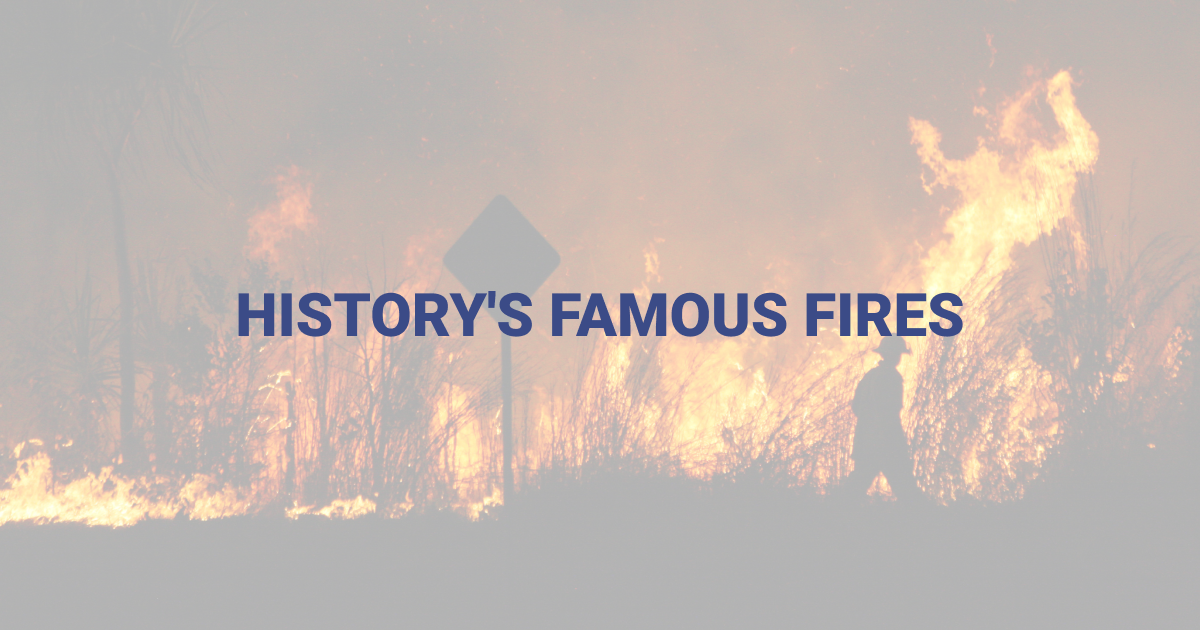
Throughout history, fires have been rife, with several of them affecting the population forever, changing the course of world events.
Famous Fires in History
The Great Library of Alexandria
The most well known library of the ancient world, the Great Library of Alexandria contained a wealth of knowledge, with between 40,000 and 400,000 scrolls from Egypt, Greece, Persia and India. The cause of the fire is unknown, and there are multiple theories of its origin. One theory says that Julius Caesar started the fire when he set his ships ablaze in the habour. However, it is also believed that part of the library survived, but was destroyed by the bishop of Alexandria 43 years later, who later built a church on the site.
The Great Fire of London
The Great Fire of London 1666 – the fire that changed London forever. Destroying over 13,000 homes, and damaging iconic buildings such as St Paul’s Cathedral and the Royal Exchange. The iconic fire started in a bakery in Pudding Lane, spreading quickly throughout the city due to strong wind and structures being mainly constructed from wood and thatch.
It took over 30 years for the city of London to be rebuilt, but this brought with it new restrictions on how properties were built – for example, restrictions on upper floors no longer being able to jut out over the floor below were put into place following the great fire.
The Great Fire of Rome
Although common sense tells us that ‘Rome wasn’t built in a day’, it was almost destroyed in a matter of days. The great fire of Rome in 64AD destroyed 71% of Rome, spreading quickly due to high winds and the majority of structures being made out of timber. Although the cause has never been confirmed, it is likely that the blaze started in the merchant shops where flammable materials were kept.
Great Chicago Fire 1871
The Great Chicago Fire claimed 300 lives and destroyed property on a vast scale – making 100,000 homeless. Although the exact cause is unknown, research states that the fire started in the southwest of Chicago, quickly spreading throughout the city, and was exacerbated by fires already burning in nearby neighbourhoods due to hot weather. Additionally, a fault with the local watchmen also meant that the emergency fire department were initially sent to the wrong place, leading to the fire further spreading.
Back then, in addition to structures being made out of wood, so were pavements and roads – so it’s unsurprising that it spread so quickly.
Grenfell Tower Fire
One of the most recent, heartbreaking fires that was the deadliest structural fire in the UK since 1988, the Grenfell fire disaster caused 72 deaths. The fire, believed to have started accidentally in a refrigerator, was accelerated by the building’s exterior combustible aluminium cladding, spreading to all four sides of the 24-storey public housing structure within minutes. Since the fire in 2017, there have been protests and a public inquiry, asking for better structural restrictions to ensure nothing of this kind occurs in the future.
Australian Wildfires 2020
The Australian wildfires from 2019/2020 caused devastating effects – ones that we are still recovering from four years on. With rainfall at its lowest level since 1990, and the hottest and driest year on record, it was a recipe for disaster. The impact of the wildfires on wildlife was catastrophic, killing over 3 billion animals, including 61,000 koalas. The bushfires ravaged 42 million acres of land, destroying buildings and killing over 40 people.
Learning From History
These fires have given us lessons on how to avoid blazes in the future, and are a stark reminder of the importance of fire safety.









